Structure & Load Research Group
STRUCTURE & LOAD
This group conducts research on analysis technology necessary for ship structural safety evaluation and development of whole ship direct load and structural analysis system.
Focusing on finite element analysis (FEM), this group conducts R&D of wave load prediction programs, including non-linear loads such as slamming and sloshing, and fluid-structure coupled analysis methods, as well as a model experiment at water tank and structural model test to verify the accuracy of analysis programs. This group carries out model experiments and accumulates advanced experimental technology. Recently, this group has been conducting research on digital twins for ship structure to support safe operation utilizing the analysis technology.
This group reflects the results of the research in rational standards and classification rules.

Research Overview
1. Direct Load & Structure Analysis and Evaluation System on Whole Ship: DLSA
We are developing DLSA for a whole ship, incorporating the most advanced load and structural analysis methods. In the DLSA, there are four analysis/evaluation procedures: "DLSA-Basic," "DLSA-Basic W," "DLSA-Professional," and "DLSA-Advanced Technologies." Each procedure is a combination of modules according to the target strength evaluation. In the procedures, the user can also input the specific sea condition. At the same time as the development of DLSA, we are developing a GUI (graphic user interface) to use the software easily in the actual design field.
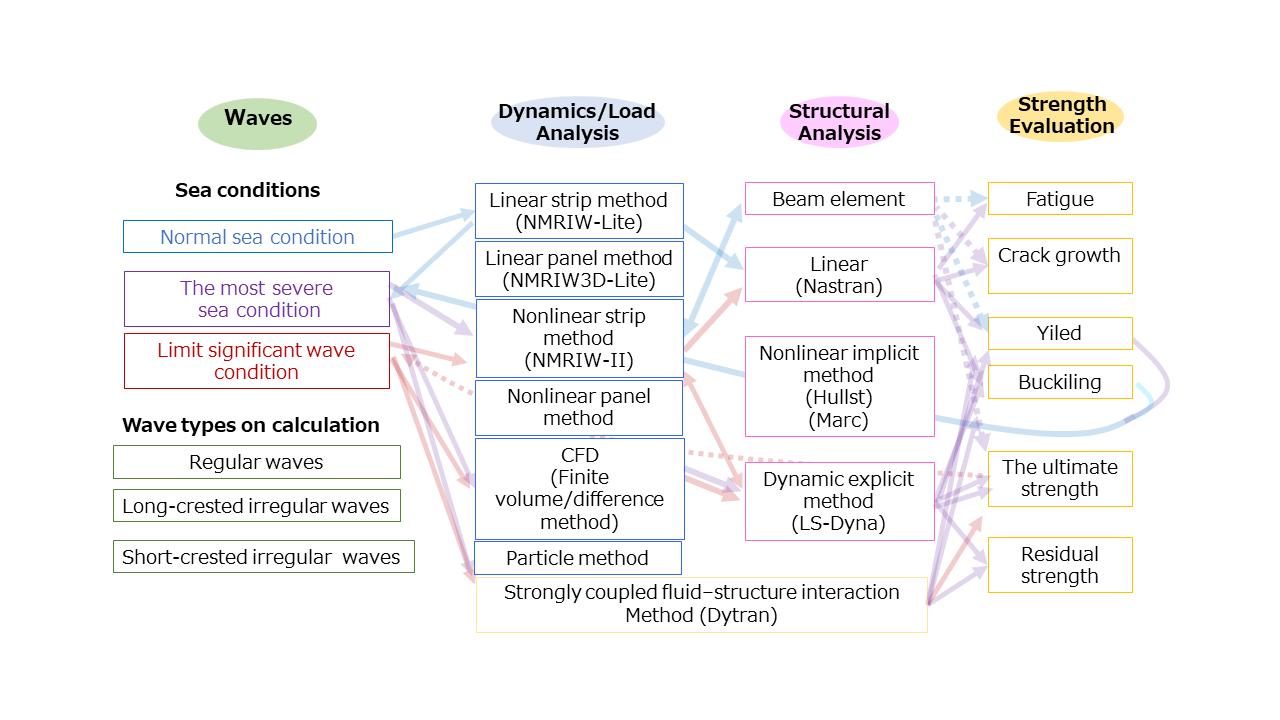
<DLSA-Basic>
DLSA-Basic is a system with the most basic functions based on linear theory. It can execute high-speed and robust integrated ship load/structural analysis. We can select the load function from the linear strip method "NMRIW-Lite" and the linear 3D Green's function method "NMRIW3D-Lite." We can also identify the most severe sea conditions based on the short-term and long-term prediction of load or yield/buckling strength.
―Related Paper―
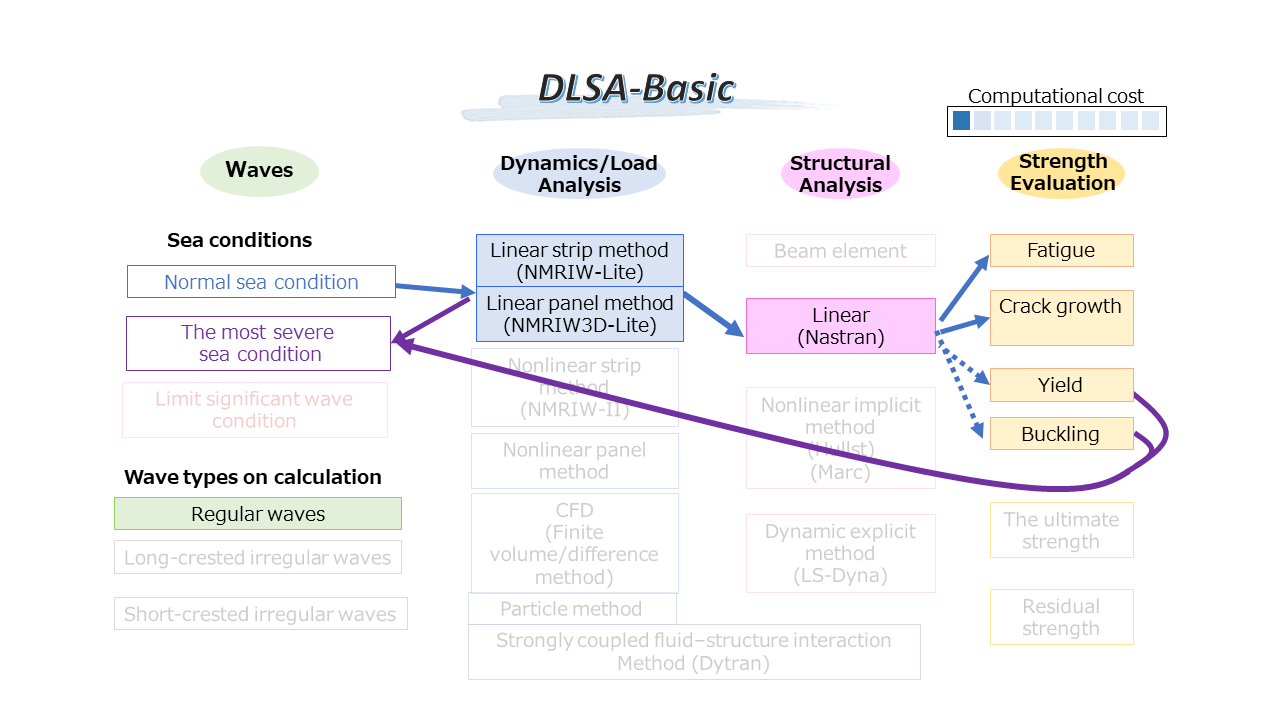
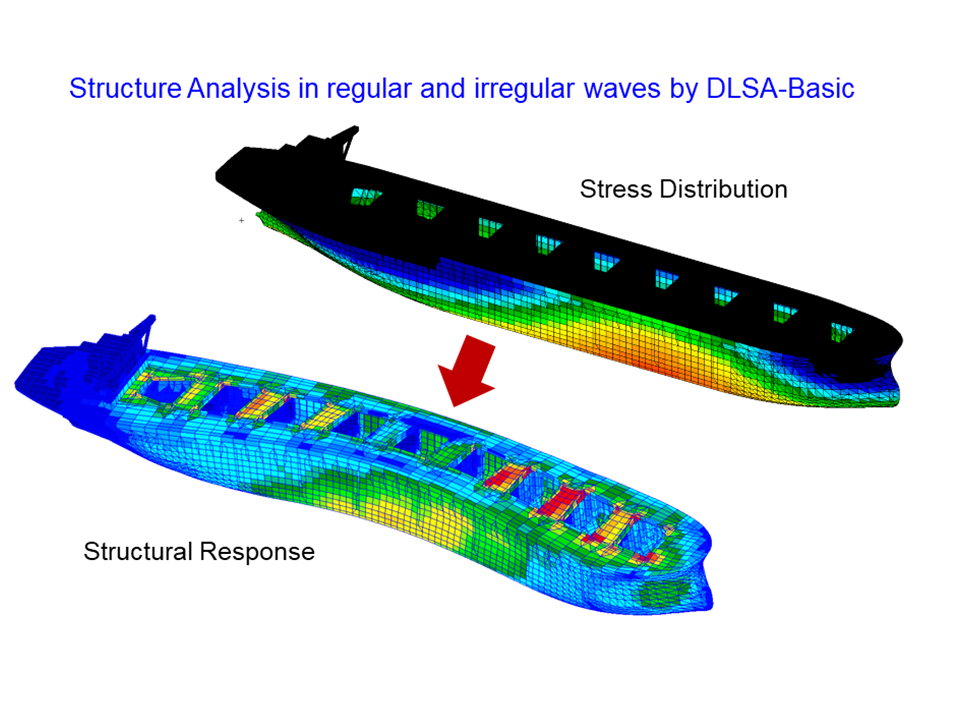
<DLSA-Basic W>
"DLSA-Basic W" is a simple analysis system based on non-linear theory that targets the response under the most severe sea conditions specified by DLSA-Basic. It can consider non-linear phenomena such as slamming and green water in motion/load analysis. In addition to structural strength evaluation, it is also possible to identify the limit significant wave condition with a model incorporating a non-linear beam.
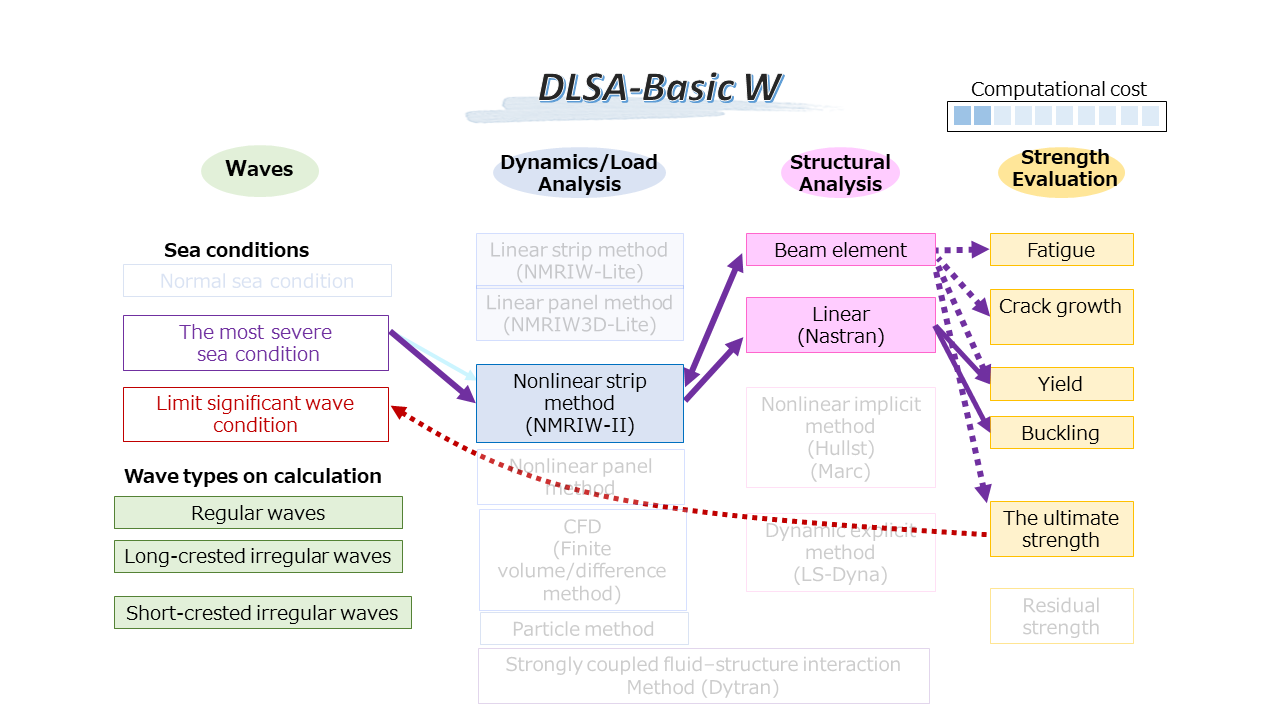
<DLSA-Professional>
DLSA-Professional is a system that targets the ultimate strength and residual strength evaluation. Usually, the former strength has been evaluated separately from the fluid analysis. This system combines the load analysis and the fluid one to present a method for filling the gap between simulations and the actual phenomena. It also plays a role in identifying the limit significant wave condition from the ultimate strength evaluation results.
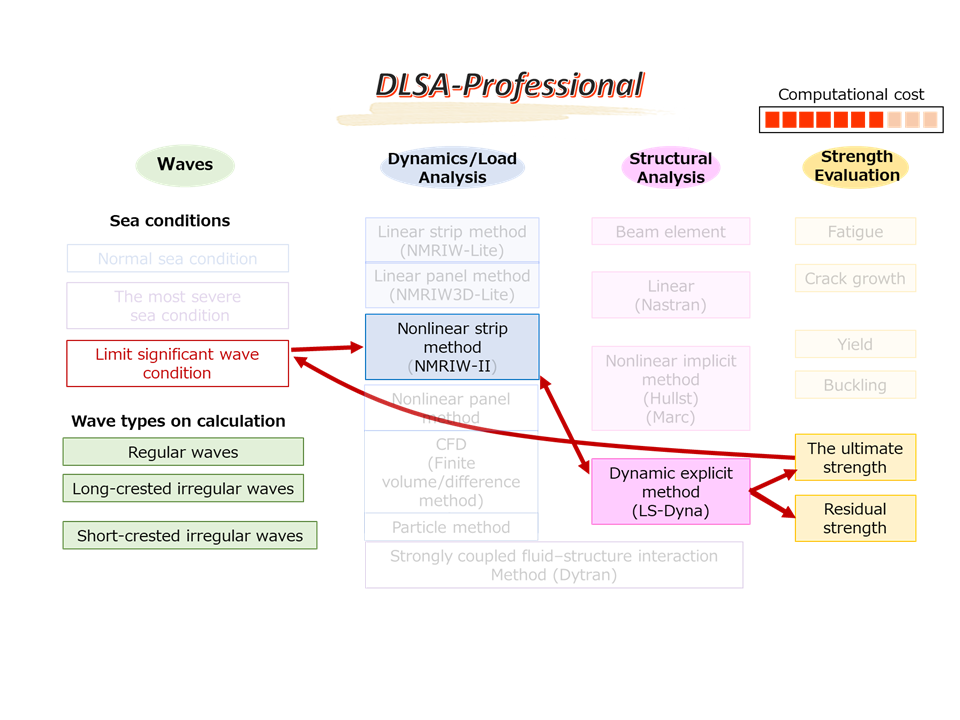
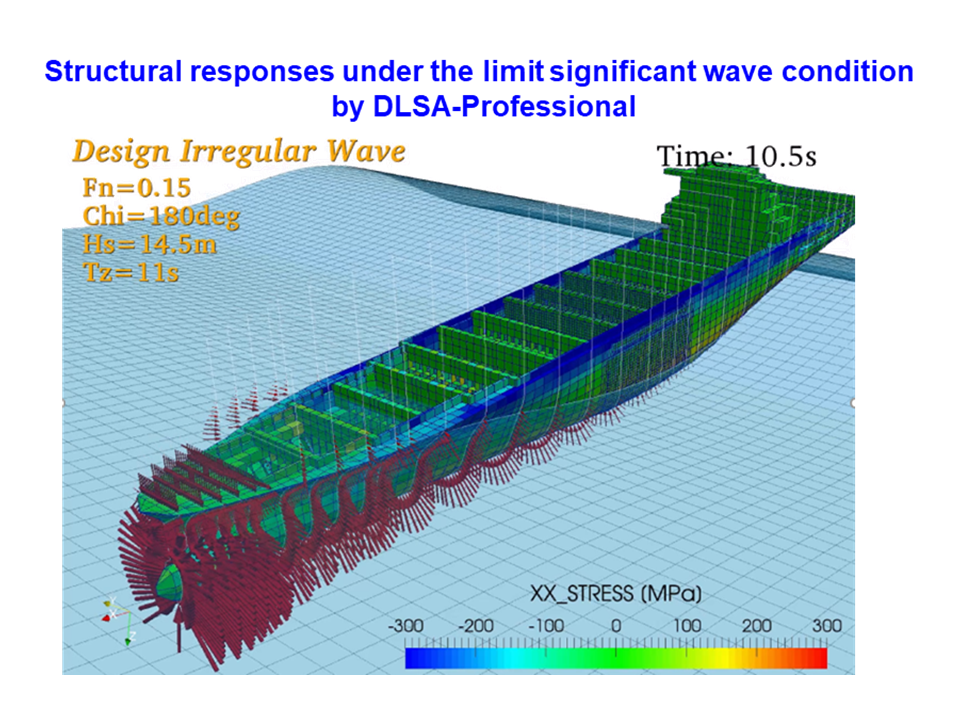
<DLSA-Advanced Technologies>
DLSA-Advanced Technology is an advanced system that utilizes the latest simulation technology in both fluid and structure. We are developing it as an integrated whole shipload/structural strength evaluation system that executes weakly coupled analysis that alternately transfers output data of motion/load analysis and structure analysis. CFD-FEA coupled analysis can be performed with the CFD code (NAGISA) developed by NMRI as the load simulation tool.
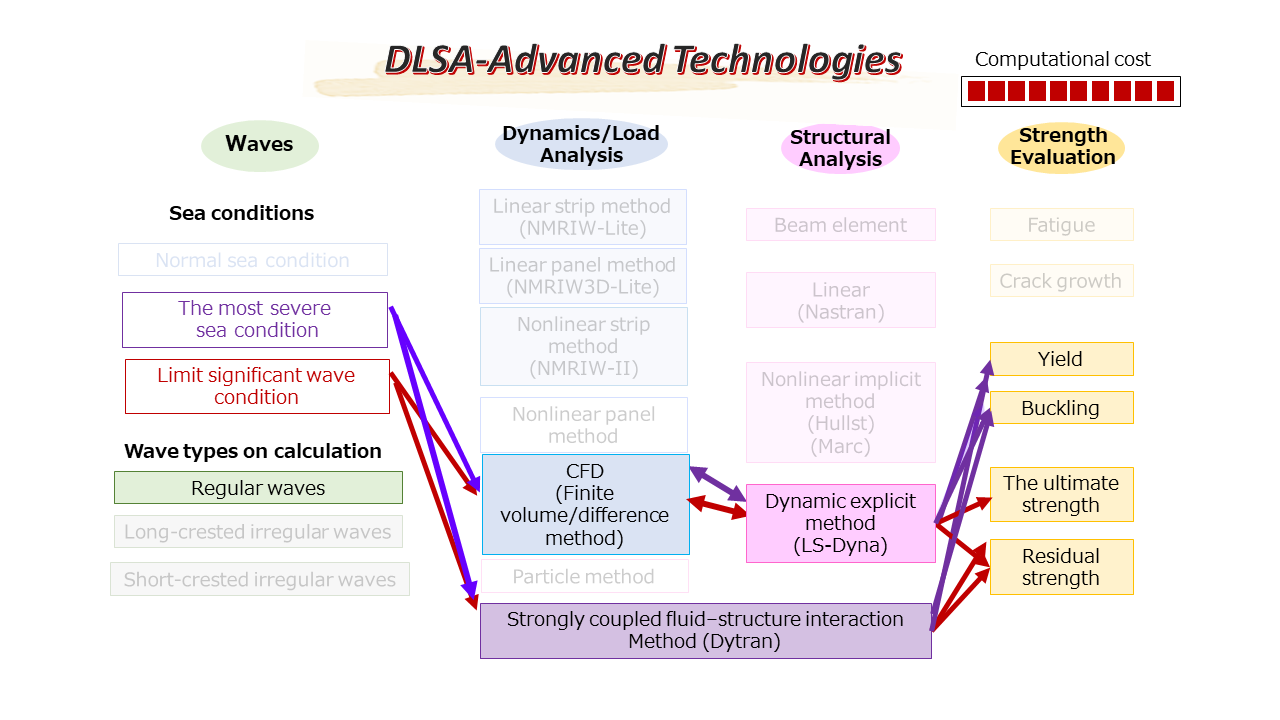
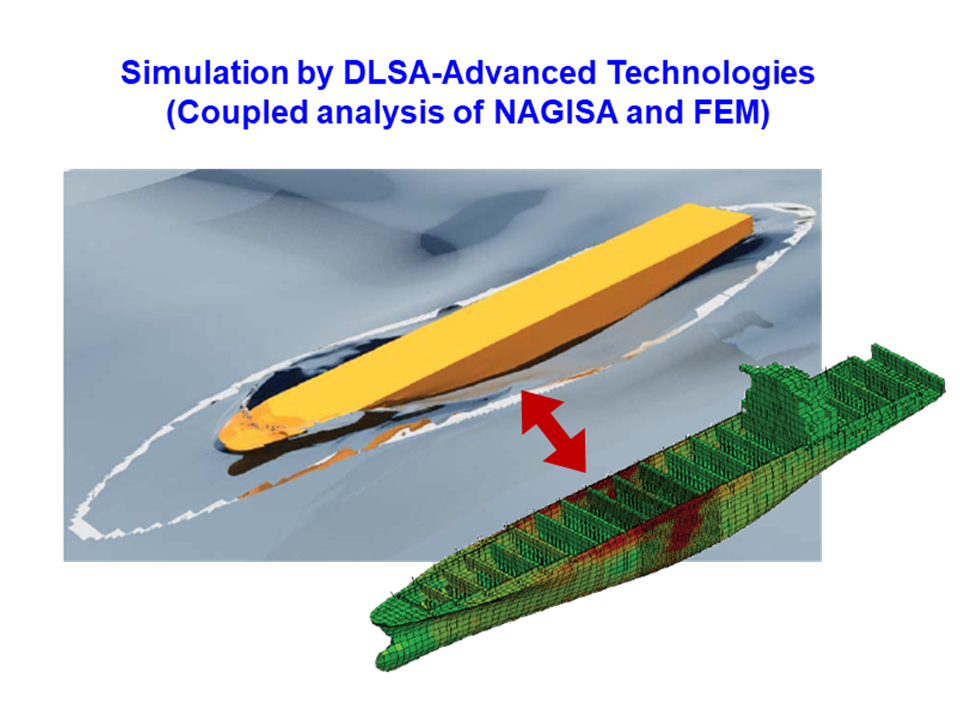
2. Development of NMRIW-II (Nonlinear Motion in Regular & Irregular Wave-Integrated Intelligence)
We have newly developed NMRIW-II as a motion/load analysis tool in waves. NMRIW-II (Nonlinear Motion in Regular and Irregular Wave-Integrated Intelligence) is based on the nonlinear strip method and can analyze the nonlinear ship response, including slamming and whipping under various wave conditions. The load obtained by this tool can be transferred to the structure analysis seamlessly on the DLSA interface.
―Related Papers―
Sadaoki Matsui, et al., "Development of a Nonlinear Wave Load Analysis Program NMRIW-II for Ship Structural Design", NMRI Report, Vol. 17, No. 3, pp.247-293. (2018) (in Japanese)
Sadaoki Matsui, et al., "Validation of the Nonlinear Wave Load Analysis Program NMRIW-II in Comparison with Experiments ―Ship Responses in Regular Wave―", NMRI Report, Vol. 17, No. 3, pp.297-380. (2018) (in Japanese)
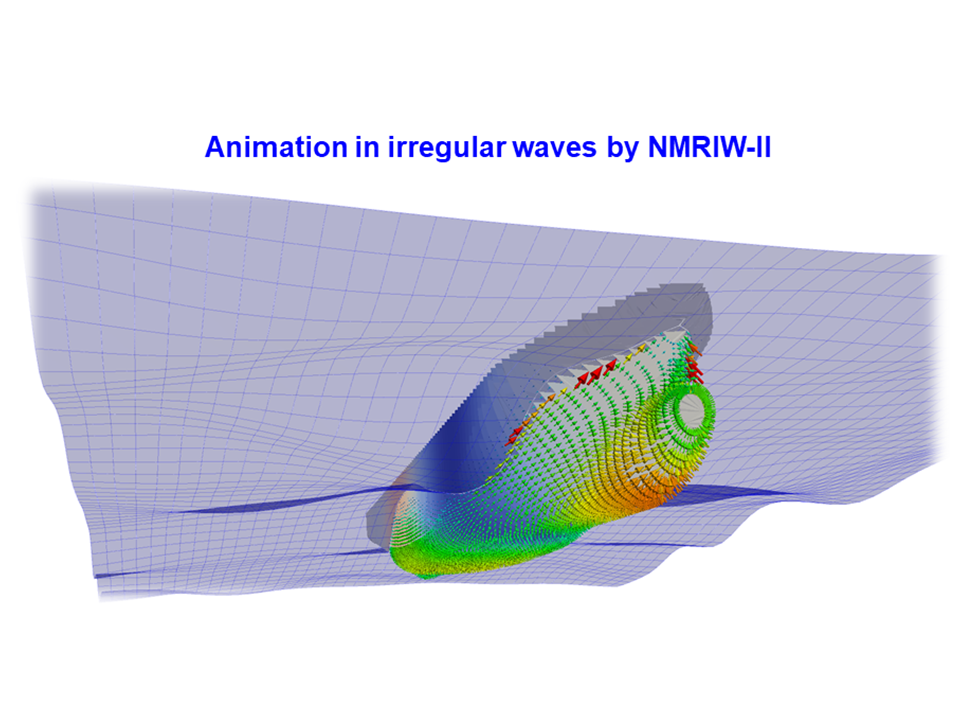
3. Collaboration with ClassNK
This Group conducts research that contributes to the development/revision of rules and guidelines in collaboration with ClassNK. It is an organization that develops rules and guidance for the survey and construction of steel ships.
<Development of regular formula for wave loads>
Correct estimation of the wave load is necessary for evaluating the safety of hull structural strength. Since this group has developed load analysis tools such as NMRIW-Lite, NMRIW3D-Lite, and NMRIW-II described above, we can reasonably estimate the wave load using them. On the other hand, according to the classification rules, the estimation by a rule formula is required to avoid the difference among the estimation results that depend on analysis tools. To meet this requirement, we are developing a simple formula that can readily and reasonably estimate the wave load by utilizing the know-how cultivated in creating the load analysis tools.
<Validation of the evaluation method of hull structure strength under the current rules>
In the hull structural design, it is necessary to provide optimum strength considering the various wave loads the hull receives during navigation. The current steel ship rules and guidelines stipulate a method to evaluate the maximum stress generated during the service life of a ship based on the responses to several typical wave loads. However, in recent years, the shape and dimensions of vessels have changed significantly compared to those of the day when the current regulations were established. Therefore, this group contributes to revising rules and guidelines by conducting a more rigorous analysis considering all kinds of waves using the DLSA system.
―Related Paper―
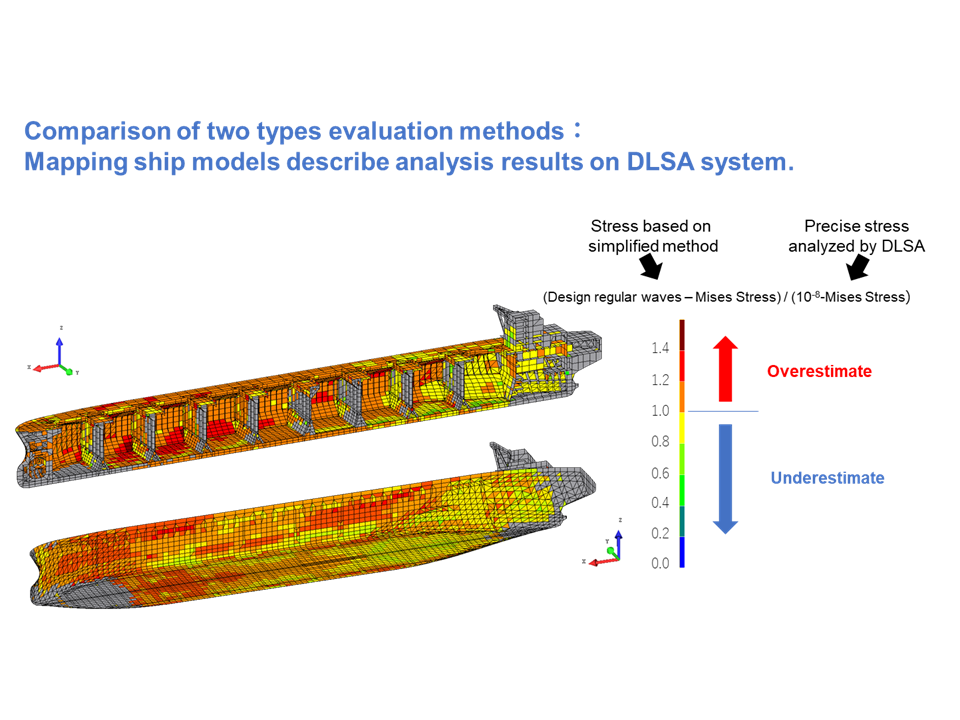
4. Development of Hull Structure Digital Twin
We are engaged in the research and development of "Structure Digital Twin." Using this system, we can faithfully reproduce the state of the hull in the structural model on the computer-based on sensor measurement data such as strain and acceleration generated in the hull during navigation. Using this system enables us to predict and evaluate the soundness of the hull in real time, short-term, and long-term.
Research and development of hull structure monitoring is progressing as a technique to know the state of the hull. It is impossible, however, to directly measure the waves that the hull encounters in the actual sea area and the external force acting on the hull. And there is a limitation on the number of strain sensors mainly because of cost. Therefore, developing the technology to estimate the stress and other state quantities of all ships, based on the minimum necessary information, is expected. To meet this need, we are developing the technology to estimate the post-service state quantity using the direct loads and structure analysis program (DLSA) made by our institute.
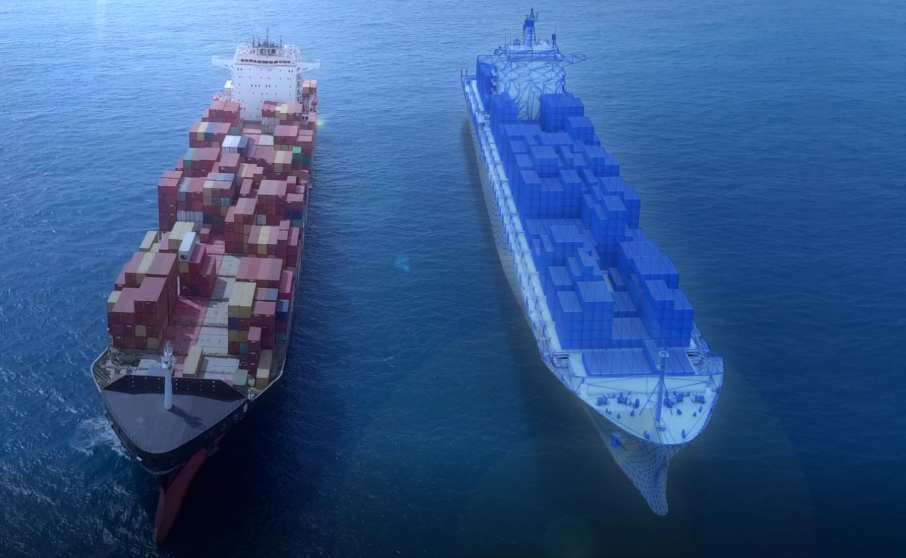
Hull Structure Digital Twin
Cyber Space (Numerical Simulation)
Physical Space (Experiment)
5. Research on Sloshing
We are evaluating the safety against sloshing by using the sloshing test equipment and large-scale rolling test equipment, both of which are attached to the wave load test equipment. The below photo and movie show a forced rolling test of a MOSS-type (independent Type B) LNG tank. In this experiment, the sloshing of the primary resonant flow generated in the swaying direction and the swirling of the horizontal rotating flow caused by the mode transition from the sloshing were reproduced. We are also conducting a finite element structural analysis to confirm whether the strength of the tank is sufficient for such a violent flow. In addition, we simulate the flow in the tank using the particle method.
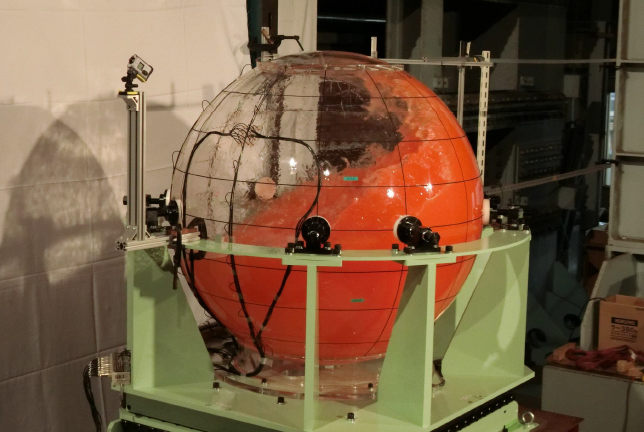
Rolling Test Equipment of a MOSS Type LNG Tank
Rolling Test of a MOSS Type LNG Tank
6. Study on Ultimate Strength of Continuous Stiffening Panel Subjected to In-plane Shear
Most of the structure of a ship is composed of continuous stiffening panels that combine plates and beams (stiffeners), and the ultimate strength of continuous stiffening panels is crucial for ship safety. Consecutive stiffening panels with longitudinal bulkheads such as VLCCs have relatively large in-plane shear stress in addition to in-plane compressive stress due to longitudinal bending of the hull. The final strength of continuous stiffening panels, in which in-plane shear is dominant, is unclear.
In this research, we are developing a final strength evaluation method for consecutive stiffening panels considering in-plane shearing. We are also conducting buckling and collapse tests for verification. The buckling collapse behavior of stiffened panels under shear and compressive loads has not been fully elucidated, and no rational evaluation method has been established. In this study, we conducted buckling tests on a stiffening test panel of a longitudinal bulkhead of VLCC, and we reproduced the buckling collapse of a consecutive stiffening panel subjected to in-plane shear and compression. We also proposed a simple FEM analysis method for continuous stiffened panels using the periodic boundary condition (PBC).
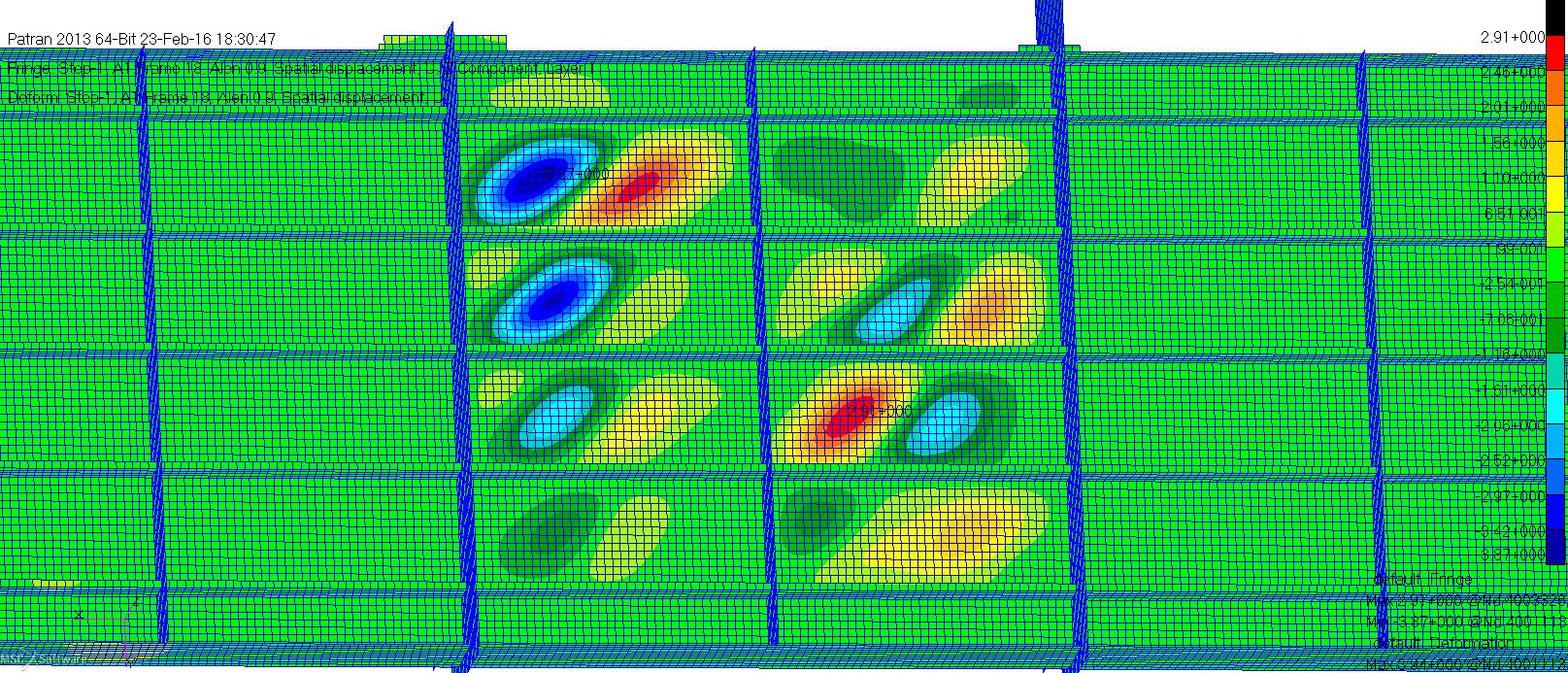
Result of FEM analysis
Movie of Model Test
7. Research on Slamming and Whipping of Container Ships
Slamming occurs when the ship breaks the waves with its propulsive force or is struck by the waves and hits the water's surface. Accurate estimation of impact load due to slamming is crucial to design a safe and economical ship.
This group conducts research to analytically determine the slamming impact load of a container ship using Computational Fluid Dynamics (CFD) and Finite Element Method (FEM).
Figure 1 compares the impact load predicted by CFD with the experimental value for the evaluation points on the bow. We can see that the peak water pressure due to impact can be accurately estimated. In addition, by combining CFD and FEM, it is possible to predict the elastic vibration (whipping) of the hull due to slamming. Figure 2 compares the experimental value of the vertical bending moment in the center section of the hull. By applying this research, it is possible to estimate the impact load on the upper structure due to seawater injection and on the stern part, to evaluate the final hull strength more rigorously, to predict the wet deck slamming of catamarans, and to achieve innovative contribution to the ship hull design.

Fig. 1 Comparison of the Impact Load by CFD and the Experiment
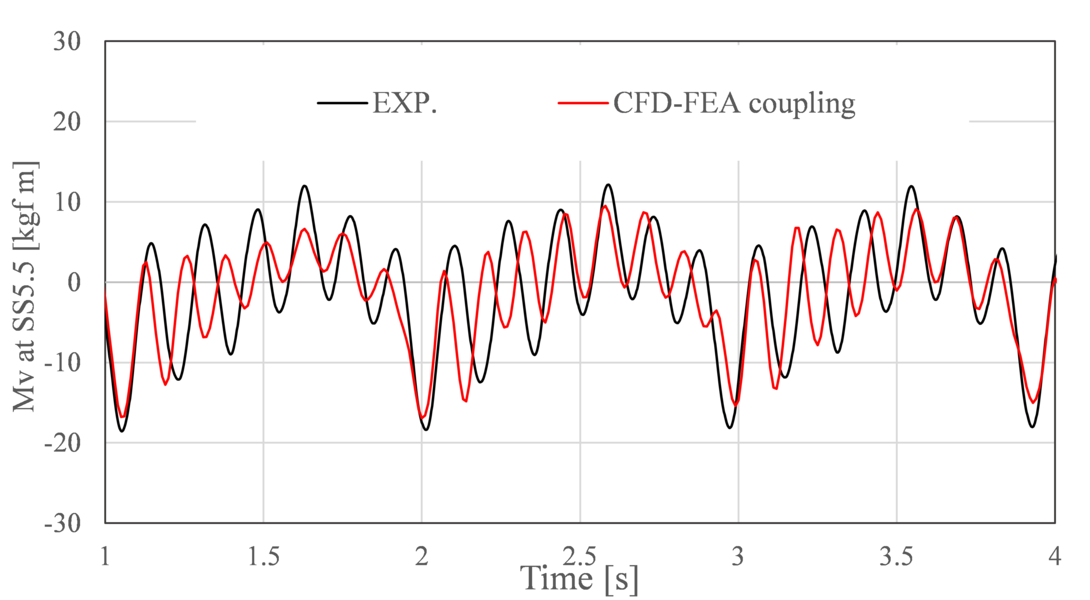
Fig. 2 Comparison of the Elastic Vibration (Whipping) of the Hull due to Slamming by CFD and the Experiment
